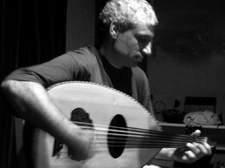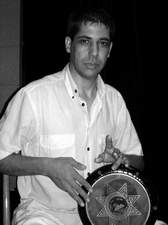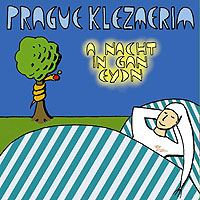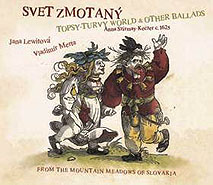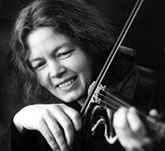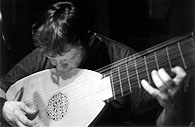ARTA reflexions - New Releases |
|
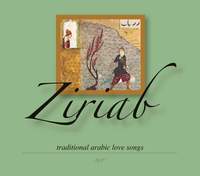
Arabic folk songs about love
- Samra ya samra 5:24

- Salamat 5:33
- Afdika 2:24

- Eini bitrif 5:58

- Hayyamatni 3:24
- Jannaat 4:27
- Hledani 2:16
- Mili 7:06
- Mayyel 6:00
- 'Alal aqiq 5:19

- Fogil nakhl 6:09
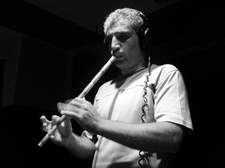
|

|
Marwan Alsolaiman - oud, nay, bendir, vocal
Haitham Farag - vocal, darbouka
Mouin Abu Chahine - vocal
Ziriab was a ninth-century Arab musician who lived Baghdad, where he was the student of a famous teacher, Ishaq al-Mawsili. Fearing he would be overshadowed, Ishaq al-Mawsili took an intense dislike to his talented pupil. Ziriab left Baghdad and set out on journey across the Islamic Empire all the way to Andalusia, in what is today Spain. There, his music talent reached a peak, not only in the virtuosity of his playing the lute and other instruments, but also in theory. He founded a music school and made a number of changes to musical instruments that were well known at the time, particularly the 'Ud (or Arabian lute), to which he added a fifth string and completely altered its construction.
Many years later, in 1997, a few Arab residents of Prague founded a music group, and named themselves after the ninth-century master. The group has gone through several changes; at present it comprises two Syrians, Marwan Alsolaiman, who plays the 'Ud (Arabian lute) and Nay (or Arabian flute), and sings, and Haitham Farag, who plays the darbouka (Arabian drum) and sings, and a Lebanese, Mouin Abu Chahine, who sings and plays the daff (Arabian tambourine).
Ziriab sings its own arrangements of songs known throughout the Arab world. Some are so old that their origin can no longer be determined. They are therefore folk songs in the true sense of the word. Others have definite authors, but are so old and familiar that they have actually become folk songs. The third source from which Ziriab draws its repertoire consists of newer songs that nonetheless acknowledge the sounds and arrangements of classical Arab song.
The songs on this album come from all three sources. All are about love, as indicated by the subtitle, but each is slightly different from the next.
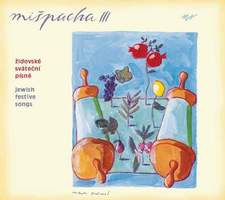
jewish festive songs
- Vesamachta 2:49
- Uvau haovdim 2:01
- Jisrael Jisrael 2:19

- Ma nistana 2:36
- Al taster panecha 4:14
- El nora alila 2:26
- Sisu vesimchu beSimchat Tora 1:45
- Simchu na 2:58
- Mipi El 3:01
- Chanuke 1:43

- Jemej haChanuka 1:26
- Erec chita 1:56

- Asira la-Sem 3:32
- Pitchu li 1:41
- Sira chadasa 1:38
- Zajt se Jidn 1:48
- Sosanat Jaakov 2:08
- Jom tov lanu 1:20

- Umordechaj jaca 1:40
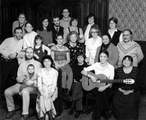
|
Tereza Bouckova, Helena-Ester Divecka, Ester Jerochim, Chana Jerochim, Chaja Jerochim, Helena Klimova, Helena Kovanicova, Sara Miletin, Zlata Palkovicova, Anna Sterecova, Iva Steinova, Kacka Steinova, Hana Skoumalova, Zdena Skoumalova, Irena Tausingerova, Lenka Termerova Lukas Pellar, Jakub Roth, Petr Vacek, Martin Vyhnalek
guests:
rabi Jehuda Jesarim: vocal;
Tereza Rejskova: violin;
Michal Kostiuk: clarinet, bass clarinet, soprano saxophone;
Jens Kruger: accordion;
Vitezslav Janda: bass, percussion.
As the body needs food, the soul needs happiness. The Jewish festivals are one of the gateways to the chamber of happiness. So let’s sing festive Vesamakhta deep from our hearts.
The cycle of Jewish holidays traditionally begins in the spring with the Passover, which commemorates the departure from Egypt. The prophet Jeremiah assures us in the text of Uvau haovdim that one day we will be saved from our present exile as we were then saved from Egypt.
An important part of the Passover is the traditional Seder meal, which is accompanied by the singing of psalms. We sing these psalms to thank God for all the miracles which He performed for us, for He is the true saviour in the times of suffering. This is what Yisrael Yisrael is about.
The song Mah nishtanah invites us also to the Seder table and to the story of the exodus from Egyptian slavery. During the Seder, children should receive the answer to the question what makes this night different from all the others.
In the period before the High holidays we repent and take care of our debts and obligations. We apologize for our faults and hope that God will not conceal his face from us in this time- Al Taster Panekha.
Yom Kippur is the day of atonement and strict fasting. We spend this day in synagogues deep in prayer begging God to forgive us our sins. According to the tradition the gates of Heaven close just before the end of this extraordinary holiday and this is our last chance to pour our hearts out. In Sephardic communities the song El Nora Alilah is the final climax of the liturgy of Yom Kippur.
The month of Tishri is very rich in festivals. After the day of Judgement during Rosh Hashana and the fast of Yom Kippur there are eight days of Sukkot and Simchat Torah- the day when we conclude the reading of the Torah scroll. The time of Sukkot and Simchat Torah is a time of exceptional happiness, as we sing in Sisu Vesimhu beSimhat Torah.
In the text of Simchu na all of us without exception are invited to rejoice at the completion of the cycle of Torah reading. Happiness has the power to overcome all differences and therefore in the synagogue there are children dancing with old people, with scholars and also those who prefer not to study much.
Mipi El is a part of Sephardic liturgy for Simchat Torah. The soloist sings the given text and the choir react with the refrain. Each verse is a sophisticated praise of God, Torah, Moses and the people of Israel.
The Chanukah holiday is the embodiment of the philosophical clash of two spiritually powerful worlds- Hellenism and Judaism. Chanukah celebrates the victory of the Maccabee rebels over the Greek tyrants, the victory of a small determined nation over a world power. When the Maccabees liberated the Temple of Jerusalem, they cleared it of the idols and consecrated it again. The Temple of Jerusalem was the heart of the Jewish people, it stood on the most sacred place on Earth. We do not, to our great regret, have the Temple anymore, but we ask for it being rebuilt in our everyday prayers. Both Chanuke and Yemey ha Chanukah are about Chanukah happiness.
Tu B’Shevat is the New Year for Trees. In the Torah we read that ”a man is a tree in the field”, on Tu B’Shevat we are aware of our relationship to trees and the land of Israel which was blessed with seven exceptional kinds of fruit. Eretz Chitah is one sentence of the Torah: "a land of wheat, barley, grapes, figs, and pomegranates - a land of oil, olives and honey [dates]".
On the first day of a new month, Rosh Chodesh, we pray for a blessing for the ensuing month. We add still more prayers of gratitude and praise into the regular prayers in which we thank God for every single moment that he grants us and in which He looks after us. Ashira la-Shem is a special Rosh Chodesh psalm and as well as Pitchu li is chosen from this particular book of the Bible. We have taken the latter from the liturgy for the holiday.
With Shira Chadashah we are coming back to the times of the exodus of the Jewish people from Egypt. Even now, in our everyday prayers, we are reminded of the miracle when the waves of the Red Sea parted and we were saved by God. After fleeing from Egypt, the Israelites were followed by the Pharaoh’s army. The Jews managed to reach the shore of the Red Sea. They were trapped in between the sea and the Egyptians. People began to weep and then God told Moses: ”Tell the sons of Israel to proceed!” God split the waters of the sea and the Jews could cross it with dry feet. The Egyptians hurried behind them, but God returned the sea into its natural form and the Egyptians were drowned. Moses was inspired by this miracle to the famous song which is now sung by us, too.
The holiday of Purim commemorates the unsuccessful attempt of the evil Haman to exterminate all of the Jewish people that were living all over the vast Persian empire which reached from India to Egypt. The story is told in the Biblical book of Esther. The total extermination of the Jewish people seemed almost inevitable, when the situation changed miraculously in our favour. That is why Purim is full of humour. Usually, stage performances are held in which everyone, both adults and children, likes to take part. And in the song Zajt she Yidn we are told to be quiet as the Purim play is beginning right now!
Shoshanat Jaakov introduces the characters of the Purim story. Some of them deserved praise, some damnation. If you listen carefully you will hear a sound similar to the rattling of gragers. These are used in synagogues during the reading of the book of Esther, the Megillah, to drown out the name of the villain Haman.
The words of Yom Tov Lanu mean simply that ”it is Purim and we will rejoice”. Although the text speaks specifically about Purim, joy is something that is associated with all Jewish holidays.
Umordecai yaca describes the moment in which Mordecai is victoriously coming out of the royal palace where he has together with Esther managed to avert the imminent catastrophe. The capital of Persia, Shushan, which had been in sorrow till that very moment, burst out applauding and rejoiced.
We celebrate Purim in the last month of the Jewish year, in Adar. The book of Esther is the last one of the Tanach and that is why we finish our singing with the holiday of Purim.
rabbi Yehuda Yesharim
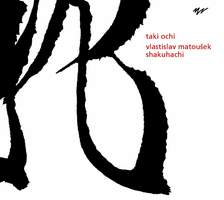
Total time - 79:38
taki ochi
- taki ochi, ryugenji

- taki ochi, fudaiji
- taki ochi, kinko ryu
- asahidaki waterfall
- inside the circle / v kruhu (composed by Vlastislav Matousek)
“The idea that something as incomprehensible and ethereal as a musical composition could be the only ‘material’ remnant of a famous temple was truly fascinating to me. What’s more, it was a composition that should sound like ‘wind blowing through a bamboo grove’. That is how the mysterious ‘blowing Zen’ or ‘blowing meditation’ (Suizen) practised by the mendicant ‘monks of nothingness’ of the Fuke-shu sect used to be described”, Vlastislav Matousek writes in the sleevenote of his last CD project.
Vlastislav Matousek earned a degree in composition, from the Faculty of Music, Academy of Performing Arts, Prague, and took a postgraduate course in music theory. On a Japan Foundation fellowship in 1996, studying shakuhachi playing with Kifu Mitsuhashi in Tokyo and traditional Japanese music with Professor Osamu Yamaguti at the Faculty of Letters, Osaka University. At the Academy of Performing Arts, Prague, in 2001, he defended his dissertation on ‘Kinetics in Ethnic Music’, earning a doctorate in Music Theory – Theory of Composition. In 1991 he began to lecture on ethnomusicology, in the Department of Music Theory and History, in the Faculty of Music, at the Academy of the Performing Arts, Prague. Since 1999 he has also been teaching in the Institute of Musicology, Charles University, Prague. As a theorist, he is concerned with non-European music, kinetics and organology. He also works as a music journalist with Czech Radio, Prague (ethnic music at the waves of the Vltava broadcasting).He has composed some quite eccentric pieces, often using exotic instruments and electronics, and prefers to use non-traditional approaches and means of expression. As an interpreter – particularly when playing the shakuhachi and other exotic and folk instruments from his own large collection – he gives solo performances of his own compositions, often in combination with electronics. With the Schola Specialis ensemble he sings and plays the historical Czech bagpipes, the hurdy-gurdy, hackbrett, platterspiel and other historic and folk instruments, in performances of medieval music and east Bohemian folk. In the Relaxace ensemble since 1979 he has been playing music for meditation inspired by the Orient, using exotic percussion (including the tabla, dholak and Tibetan bowls), folk flutes and other instruments. Their CDs include Dhjana (ARTA, 1991), Kadael (ARTA, 1993), Czech Koan, Morning Prayer and Indian Inspiration.
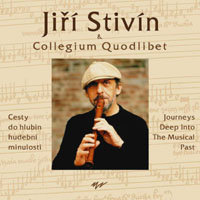
Total time - 60:00
JOURNEYS DEEP INTO THE MUSICAL PAST
- Journey with a Rose 3:08
Pulcherrima rosa - Journey to an Awakening 2:52
Danza alta - Fernando de la Torre, 16th century - Journey through Time 4:19

Primo tempore - organum, 2nd half of 14th century
Nas mily svaty Vaclave - Czech anonymous, 1st half of 16th century
O Virgo splendens - Spanish anonymous, 14th century - Journey to Delight 1:37
La Manfredina / La Rotta - Italian anonymous, 14th century - Journey of Faith 3:16
Alleluia - John Dunstable, d.1453 - Journey in Search of the Voice 2:36
Ach Gott wem soll ichs klagen - Reutterliedlein 1535 - Journey with a Dance 2:39
Saltarello - Italian anonymous, 14th century - Journey through Darkness 1:21
- Amorous Journey 3:39
Drevo sie listem odieva (Czech anonymous, 2nd half of 14th century) - Journey of Dreams 0:52
- Journey to Happiness 1:54
Povero cappator - Lorenzo da Firenze, 14th century - Journey to the Roots 6:33
Deum time - organum, Leonin, late 12th century
Viderunt omnes - Perotin, 13th century - Journey of Meeting 1:43
Wol kum, mein libstes ain - Journey of Wine 1:11
La Spagna - anonymous, 15th century - Journey of Life 8:18
Got, dine wunder manigfalt - Mulich von Prag
Edi beo thu, hevene quene - English hymn, late 13th century
Beata viscera - English anonymous, late 13th century - Journey through the Forest 1:16
- Journey of the Solstice 4:01

Ave rex angelorum - English medieval carols - Just a Journey 0:51
- Journey with No End 7:09
Cechove, mili Cechove - Czech anonymous, 1st half of 16th century
Just as the title of this recording and article is ambiguous, so, too, is the music. It has at least two meanings, which is an advantage here. Old and new music and their usual confrontation, the Dialogo della musica antica e della moderna, as Vincenzo Galilei wrote in 1581, instigating a return to the exemplar music of the ancient Greeks, and his contemporaries in Florence brought Baroque opera into being instead. Here, too, are monuments hundreds of years old beside stunning contemporary music. They may, surprisingly, be listened to each separately or together. There are examples related to the history of Medieval and Renaissance music as well as the jazz and Minimalism of the twentieth and twenty-first centuries. Ars Antiqua, Minnesang or Ars Nova next to free-jazz canons, including percussive sounds on the flute. There is serious music (from the times when it was not yet serious) and jazz (from a time when there was no such thing). The performers on this recording are specialists in authentic early music who play alongside jazzmen. There is suddenly metre in compositions that previously did not know how to work with it, new contrapuntal voices added to authentically preserved polyphony, drums in a cappella polyphony, raw sax with blue notes in the archaic organ of Notre Dame. Should anybody really dare to try such a thing today? But what else, for example, is the Cathedral of Cremona with its Lombard, Romanesque, Gothic, Renaissance and Baroque architecture all on one facade? Subsequent masters added other storeys to make new beauty and new experience emerge from the tension of the old and new. What else are actors doing when they perform Shakespeare? What else are composers doing when they borrow chants several centuries old (but, after all, the Gregorian chant borrowed melodies from the synagogue and even from Asia), and began to wrap them up in other voices from, perhaps, the seventh century? Take note, by the way, of the powerful attraction of the single drone of the bourdon. First, it was a matter of harmonies but later the nonmetrical chant suddenly began to squeeze itself from its essence into the Procrustean Bed of bar lines and accents. Talk about bold! The whole history of European music is this sort of commentary on the chant and its reworking. With independent melodies, texts and even languages the medieval motet commented on the cantus firmus, till the original musical and textual ideas were completely eclipsed by a new form. What else was Thomas Aquinas 'Doctor Angelicus' doing in his commentaries to Aristotle, but making a new philosophical-religious method which we call Thomism? Or the composer of the polyphonic mass, that is, music for the Church based on a secular melody. And suddenly, without offending anyone, the Missa parodia existed. It was not parody, however. Nor are Stivin's 'commentaries' (as he himself calls these compositions) making fun of anything. There is, however, a kind humour, which results from his ability, 'since time immemorial', to make jokes by quoting familiar excerpts, motifs and themes. It's an aspect he masters both musically and dramatically. He successfully employs three kinds of musical quotation: (1) as exposition, from which variations and improvisation are developed, (2) as a surprising cut or collage, (3) as a reversed variation, that is to say, a section where the quotation gradually hatches out of another melody or improvisation. As a listener your heart skips a beat when, sooner or later, you begin to recognize a well-known melody. With his quotations, improvisations and carefully thought-out compositions of various layers Stivin attains new forms of timbre, harmony, rhythm and meaning. Take 'Cuckoo' (track 18), for example, in virtuoso unison or stunning motor percussion. And, who today would confidently say that Stivin's current ideas don't resemble some ancient polyphony of improvisation? Stivin's music is not only ambiguous. It's not only music to listen to, but also music to watch. There are few performers of this sort whom you cannot take your eyes off during a concert. When you watch him playing, it's clear from his engagement that he is incapable of fakery. When he plays, he's living it.
Stivin: DIRECTIONS
The directions are easy; simply prescribe the required amount for yourself. Take any music by Jiri Stivin (born in Prague in 1942), preferably Cesty do hlubin hudební minulosti [Journeys Deep into the Musical Past], but it has to be played - sheet music is useless. Stivin is most effective live in concert. Neither the instrument nor the style of music nor the ensemble matters. Descendent of an inventor and an actress, he himself was a cameraman from FAMU. He plays everything and with anybody, though he has an uncanny knack for finding superb musical collaborators, ranging from the groups Jazz Q, SHQ, Blue Effect and Rudolf Dasek, Gabriel Jonas, Michael Kocab, Milan Svoboda, Pierre Favre, Alan Vitous, Vaclav Uhlir, the composers Ivan Kurz, Jan Klusak, Marek Kopelent, Milos Stedron, to Collegium Quodlibet, his own protean ensemble. You can see the music in Stivin's eyes, he's got it in his legendary cap, up his sleeve, flowing in every vein. How to take: for all sorts of melancholy, any aches and pains, as well as joy. Taking the prescribed quantities of Stivin should cause no side-effects apart from creativity, joie de vivre, a sense of belonging, optimism and a humorous outlook, together with full musical responsibility and artistic integrity. How much to take: To maintain sufficient levels of this important medication in the body the following doses are recommended: Stivin can be taken either a few drops at a time or by the bottle or in tablet form. Children under twelve, once every 4 hours. Adults once every 6 hours.
stanislav bohadlo
